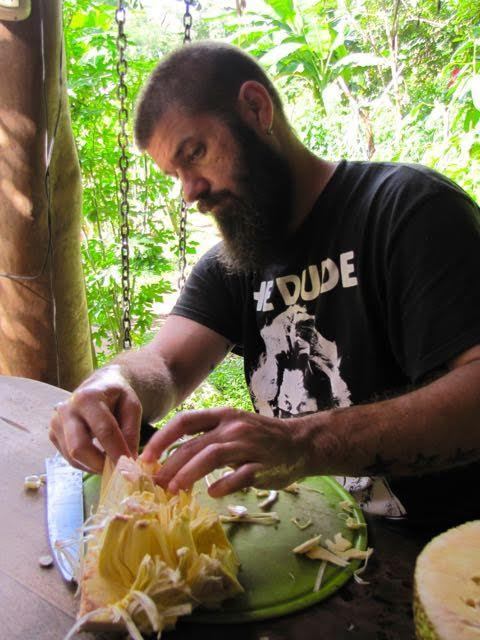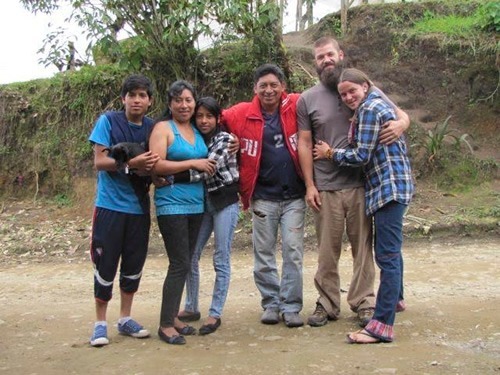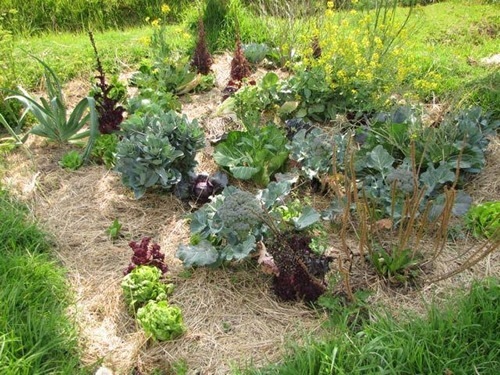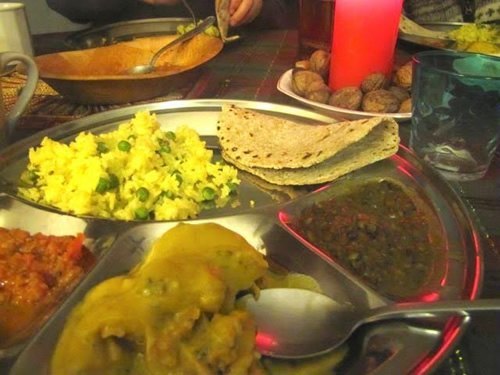9 Ways Slow Food and Slow Travel Allow for Deeper Immersion
Article by Jonathon Engels,
photos by Emma Gallagher
Published 9/3/2015

|
|
A 30-pound jack-fruit picked and sliced after
scaling 20 feet up a tree loaded with the fruit on Ometepe Island
in Nicaragua.
|
Slow. It’s a word that can, by its sheer
utterance, cause one to breathe, to stop for a moment and
soak in the world around you. Sounds are more crisp,
cool breeze feels more soothing to the skin, and the stars
appear more in focus. It’s no wonder that so many of us — especially those accustomed to fast-paced lives of drive-throughs and weekend getaways — feel a longing to slow down.
The desire to experience travel, food, and life more slowly is part of the
growing "Slow Movement" worldwide that many of us find seductive.
Vacation seems the perfect time and place to take in the slow life. Whether at a café along the streets of Paris,
with pedestrians scuffling by and Citroëns zipping past,
or in the serenity of a tropical island, waves lapping up
the shoreline, going slow brings so much more to light. Travel, in my experience, is not the time for
rushing, stressfully packing in all the sights described
in guidebooks full of must-see lists. To be memorable and enjoyable, travel is a time to slow
down whenever possible.
Similarly, food is an entirely different
experience when savored slowly, and meals become rituals born of love. Enjoying a meal is more than mere sustenance,
not meant to be consumed like fuel. Rather, food in most cultures is about communion, connection,
atmosphere, tradition, and ritual,
with notes of subtlety that enrich the very fiber of our being. Food is life. We can’t do without
it. Life can be experienced as a package of chips scoffed
on a subway ride, with greasy fingertips the only evidence
of the experience. Or eating traditional
food prepared with love can be part of epiphany that is a whole lot more
memorable.
So if ever there were a
time to stop and savor, it would be while traveling, and
if ever there were deeper means by which to understand a
culture, it would be through
the food locals eat, the way it is prepared, the ingredients
they use and value.

|
|
Volunteering with Las Tolas,
an NGO based in rural Ecuador, my wife Emma and I
stayed with this family, sharing cooking duties.
|
Let's delve deeper into why slow
food and slow
travel make for such fine companions.
1. Traditional Foods
Most everywhere in the world there exist
traditional foods, those ceremonious staples that have been
passed down through generations. It’s not an uncommon experience
as a tourist to sample local specialties when visiting someplace
new, but often these dishes merely scratch the surface,
kind of like only tasting a kebab in Istanbul without trying more dishes from the varied Turkish
cuisine. No doubt, trying known local specialties is
an important part of visiting any new destination. But,
doing so hardly does justice to the rich and rounded
culinary traditions that are peppered throughout the country.
Here is where slow travel comes in:
It provides time for more than what we recognize from our
televisions, other media, or stereotypes we may have ingrained
in our minds. There is an opportunity to explore, and to discover,
for example, that during Ramadan, all of the corner markets
suddenly start carrying a special type of bread (the
only time that bread is sold), or that the region around
Cappadocia is famous for a flatbread dish called gözleme.
Location and timing often change everything. Visiting
different streets or blocks in a borough in New York might
mean a completely different dining experience. Foods served
on holidays are almost always specific and special.
-
Tip: Before heading to a destination,
investigate any local holidays that might be happening,
or which region is famous for its good food. Such
events or locations connected with (traditional) good
food are great reasons to adjust your travel itinerary.
2. Seasonal Produce
The time of year also makes a great
difference regarding the kinds of foods available, and for
every region, climate, and season, there seems to be a different
fruit or vegetable or produce to enjoy. Just as apples or
strawberries have familiar peak seasons, so do the crops
of other countries. Panama may be a place we associate with
tropical fruits, but unless it’s early rainy season — May
to July — nary a mango will likely be found. In season,
however, they are falling from trees along the
side of the road.
The slower the travel, the more seasonal
changes will color a place like a painting. There isn’t
just mango season in Panama. There is such a vast and varied
array of fruiting trees, each with its own identity, value,
and associated recipes within the culture. Nance was
another great Panamanian experience. For a month
every year, the tiny
fruit is used to make a special drink (chicha
de nance), and a peculiar
soup. In season, market stalls are fully stocked with bottles
of nance.

|
|
Panama is a tale of two climates.
Areas like Boquete, in the north, grow more cool weather
items such as lettuces, cabbages, and the like, while
the areas in the south around Panama City are incredibly
hot and abundant with tropical fruit.
|
3. Farmer’s Markets
Unlike much of
suburbia in the U.S. (granted, this is changing in a big
way recently with the local food/farm to table movements),
most other countries have a vibrant small farmer’s market
scene. At local markets you can find not only the fruit and vegetables of the day,
but also a plethora of local specialties. Russia is well
known for caviar, rye, and beets (as in borscht), but a
market in Moscow wouldn’t be found without pickles stalls,
providing assorted choices of fermented krauts, peppers,
beans, and tomatoes.
Meandering through farmer’s markets,
not souvenir warehouses and storefronts for tourists, is
more pleasurable for those who enjoy slow travel. In so
doing, you will enjoy becoming lost among locals while in search of a nibble. You many even receive invitations into
hospitable local households as a result of conversations
that may ensue. Pickle stalls wouldn’t be around in Russia
if their foods weren’t eaten regularly. Much the same, many
Russia farmer’s markets feature large trucks selling fresh
milk, small breweries selling a local favorite rye drink
called kvass, as well as big plastic bottles of
beer.
-
Tip: Slow travel allows time for
repeat buying from the same market stall. Without
fail, after three or four times of seeing the same
foreign customers, local vendors will recognize
and provide special attention, free samples, and suggestions
for things to try.
4. Street Stalls and Dining "Dives"
Street stalls are not always what people
think of first when it comes to slow food, but
like stands at a market, food stalls are typically owned
by small business people with intense pride in their product.
Some stalls open in the wee hours to start preparing incomparably
delectable dishes. In Nablus, in the Palestinian West Bank, falafel stands
lurk around many a corner, but it takes a lot of sampling,
perhaps a new local friend, to find the best vendors.
Slow travel means there is time to explore
the different stalls (and make local friends) as well as
small "dives" that inevitably define the real
food — the stuff people eat daily — in a locale. That means
finding the incredible bakery buried in the souk,
the hole-in-the-wall kunafeh (Nablus’s famous dessert)
place just out of the city center. Or, perhaps, a new friend
revealing (since you’ll likely never find it yourself) where
to taste the fresh flat-bread from the family joint that’s
been baked using the same wood-burning oven for more than
a century.
-
Tip: Always check out the food stalls,
especially in neighborhoods not geared
entirely to tourism. Look for a stall with the longest
line, since it takes time and food worth a return
visit by locals to develop a regular following.
5. Foods to Remember
At every destination there lies the
potential for a love affair with its foods, and over time
the desire inevitably becomes overwhelming. In my case,
just the mere mention of tofu or mushrooms may provide a
rush of memories
from Korea. The intimate connection with the food is
only truly fostered by a relationship with local cuisine,
having it for lunch again and again, being unable to resist
it on restaurant menus, knowing the subtleties and tasting
the difference, for example, between a good soft tofu and
one that is not.
While great love affairs can be
passionate and happen quickly, foods to remember are not
mere crushes, but come only when a significant amount time is spent
together. Tofu and mushrooms, rice cakes, and pickled radishes
are not exclusively Korean dishes. But if you live on these
foods in Korea for several months, your associations and the
vibes of the country will likely become inextricably linked in your memory.
-
Tip: Don’t be afraid to have favorites.
When drinks or dishes hit the right spot, it’s fine
to get to know them. Slow travel means there will
be plenty of time to try everything, including favorites,
time and time again.
6. Festivals for All
Festivals may be completely about food,
centered on the traditional harvest cycle, or food may simply be
one aspect of a festival's rituals. When crowds of people get together, they are generally going
to become hungry, and festivals are fantastic for discovering
local foods and beverages. For example, in rural
Andalusia, where grape vines seem omnipresent,
nearly everyone makes their own rudimentary wine called musto.
And it’s not uncommon for each village to have their own musto festival.
Having time to explore small towns,
to become acquainted with homemade versus vineyard
bottled wine, is sometimes hard to experience on a
typical tour. And, undoubtedly, at that musto festival,
there will be favorite regional treats, such as migas,
a beloved and rustic product of culinary art, with hours of labor involved
in making it the right way. Without developing such intimate ties to
the place you are visiting by planning or stumbling upon a festival, it’s easy to be unaware of
such unique aspects of local life.
-
Festivals aren’t all necessarily
small, either. Always be sure to check out
thoroughly what’s happening at destinations while planning
your trip so that you are well-prepared. In addition
to good food, you may enjoy sinking your teeth into some
interesting related culture and history.
7. From the Earth
One great option to experience slow travel results from
volunteering on farms, working the land in exchange for
free room and board. The arrangement delivers more than
just a sampling of local cuisine, and participants are connected
to a particular piece of land and what it produces. Suddenly,
the mountains outside
of Bogota come alive with beautiful calendula, fresh
salad greens, massive heads of cabbage, mint that covers
the ground like grass, exotic fruits, and more. Imagine
the joys of harvesting lunch daily in such an atmosphere.
The opportunity to volunteer at a farm
is something to celebrate rather than see as a form of work
while on vacation. Is there a better way to learn the heart
and soul of a place on earth than to put the soil into your
fingers, to become familiar with its plants and fruits and
animals? Also, working on a farm can provide some
serious and lasting cross-cultural exchanges that will no
doubt remain with the visitor, possibly even changing the
way they live at home.
-
Search HelpX, WorkAway,
and WWOOF for
opportunities that are of real interest: perhaps harvesting
olives, building a cob house, staying on a vineyard,
or learning more about permaculture. (For more information,
see the section on such farm
volunteering abroad, which includes several of my
articles.)

|
|
One of the many sunken, permaculture
beds on a beautiful farm in Colombia. I was there
for two months, picking from this and the other
beds daily. It was a magical place with a steady stream
of friends and family visiting the owner, Felipe.
|
8. Home-Cooking
Away from Home
It’s all well and good to sample traditional
foods and typical local fare, but there is nothing like having a meal cooked by someone from the location,
preparing dishes as they would at home. Guatemala’s
famous local stew, pepian, suddenly becomes
so much more when the indigenous Mayan woman cooking it
is a friend, and she can reveal how many ingredients and
specific steps go into making the dish correctly, as her
mother taught her. Sure, it can be ordered in a restaurant,
but that’s not quite the same.
Such an experience often seems unreachable
to many travelers, but that’s the beauty of really slow,
long trips. When living somewhere, getting out into the
community on a daily basis, it’s hard to predict just who
will become a friend. There are chances to work with NGOs
and develop real relationships with people who might never
interact with tourists in any other situation. It makes
for something indescribably different than a postcard or
souvenir.
-
When planning a trip, search for
NGO projects that are looking for volunteers in the country
(or countries) on your itinerary. Helping a community
or area in need is not a bad way to spend a holiday.
9. Souvenir Cooking Skills
Finally, there is the gift that keeps
on giving, and that is developing the secrets and skills to bring a piece
of the local culture back home. Quality souvenirs are fantastic
reminders of adventures, but they hardly compare to the
know-how you can gain from locals. Learning how to make
your own tamales for a Costa Rica Christmas celebration
means that not only is your Central
American trip enriched with a great experience, but
also that you can recreate the dish wherever you happen
to be.
Long exposure to a place allows travelers,
for example, to spend Christmas with a local family, to
not only learn about the food they eat but how it’s actually prepared.
For younger travelers especially, but really for most anyone, looking
into homestays is a fine way to seek out this sort of exposure.
Such memorable experiences with local families are also
possible through volunteering with NGOs or on farms.
-
Cooking classes are also very popular
in tourist destinations, and while sometimes less authentic
than having someone’s grandmother teach you to make tamales,
they can be a great way to get the lowdown on
local food and life.

|
|
Staying with a grandmother on
a farm in Spain, my wife and I were treated to many
an Indian delight, including a lesson on how to make dhal and
chapattis. Here was part of the meal she made for us on our
last night, cooked with love using “things you won’t find in a restaurant.”
|
Wow! What a moment! It seems the perfect
time to book a ticket anywhere, a fine time to revisit a
favorite type of cuisine and get a little closer to it,
maybe learn a recipe or try a different dish. Slow food,
slow travel — is there any better way to live?
Editor's note: As mentioned by Jonathon,
the connection between slow food and slow travel is part
of the slow
movement, whose impetus was originally strongly influenced
by Carlo Petrini and the famous 1989 Slow Food Manifesto,
and who Transitions Abroad interviewed in Slow
Food in Italy.

|
Jonathon
Engels earned an MFA in creative writing.
He has lived, worked and/or volunteered in seven
different countries, traveling his way through
nearly 40 countries between them. His many interests include permaculture, veganism, and ways to live sustainably.
|
|
